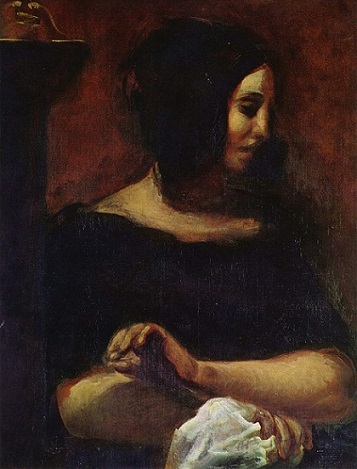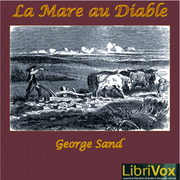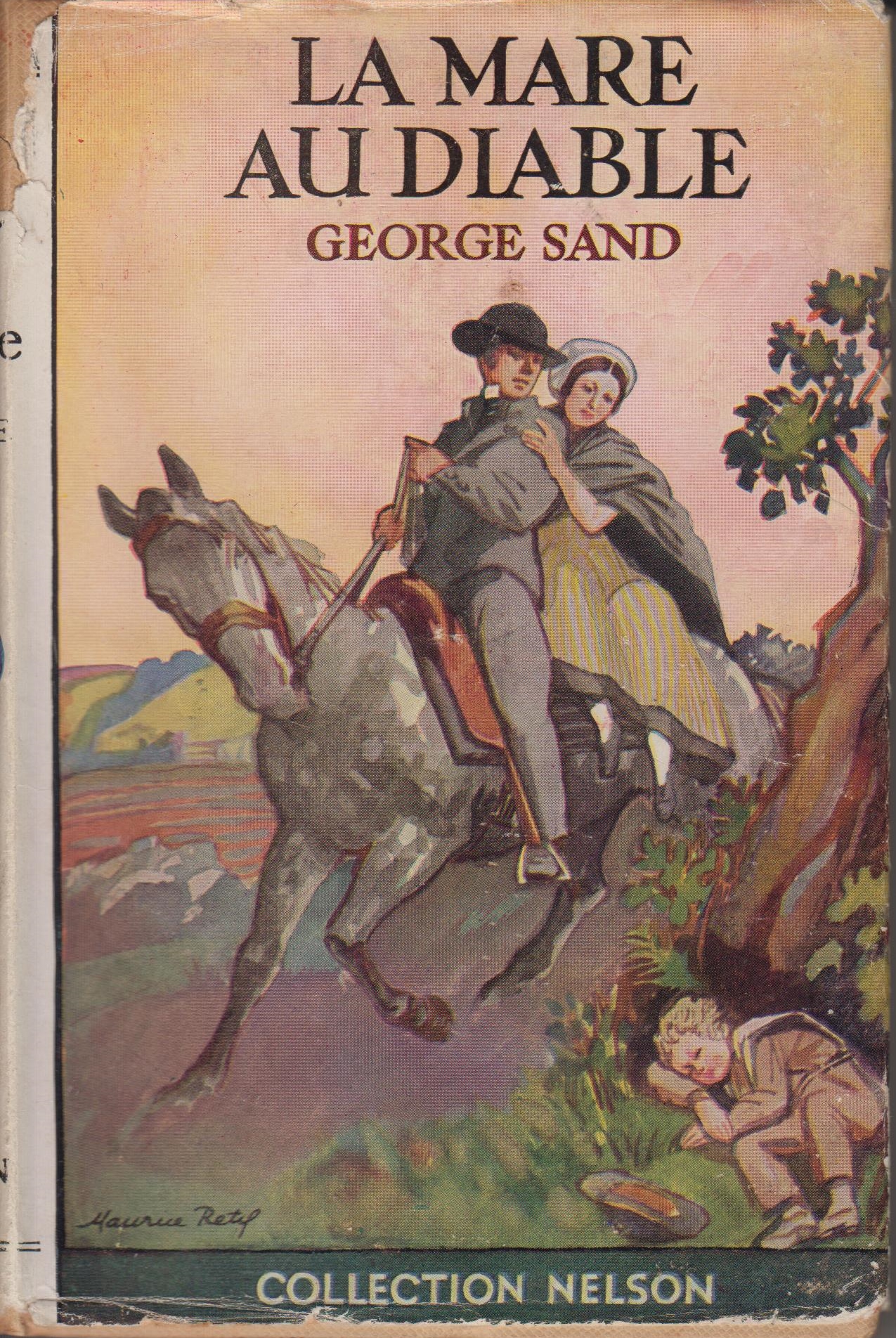
This is the third instalment of my summary of La Mare au Diable (The Devil’s Pool) by George Sand. It covers Chapters V1-X of the 1947 French edition; see here for a summary of Chapters I-V, and here for a summary of Chapters V1-X.
Chapter XI A La Belle Étoile (A Beautiful Star)
In this chapter Germain declares his desire to take Marie as his wife. Marie’s teeth are chattering and she is trembling with the cold, and when he takes her hands in his to warm them up, he is overcome by his senses and asks her to consider being his wife, despite her intention to marry someone younger. In the original French, this is signalled by his use of the familiar ‘tu’ instead of ‘vous’, but Marie continues to use the formal ‘vous’; when Marie rejects his earnest pleading, he reverts to the formal ‘vous’, a distinction which is lost in translation.
|
—Si vous m’aimiez un peu, vous ne verriez pas si clairement mes défauts. Mais vous n’aimez pas, voilà!
—Eh bien! ce n’est pas ma faute, répondit-elle, un peu blesse de ce qu’il ne la tutoyait plus… (p.142, underlining mine)
|
—If you loved me a little, you would not see my faults so clearly. But you don’t love me, you see!
—Well, that’s not my fault, she replied, a little wounded that he no longer used the intimate form of address.
|
The conversation falters: Germain holds his head in his hands cursing his lot and wishing he were dead, while Marie, too astonished to sleep, tends the fire. When dawn breaks, he is too discouraged to ask how she is, though he knows she hasn’t slept. He gathers their belongings, takes Petit Pierre in his arms, and asks if Marie still wants him to escort her to Ormeaux?
No, she does not, and this wounds him further. They set off and a passing wood-cutter sets them on the right route to got their separate ways, but also tells him that Grise is in his yard. Germain decides to retrieve the horse first. Marie offers to clean up Petit Pierre and look after him at Ormeaux until Germain is ready to present him to the woman at Fourche. Somewhat bitterly, Germain scorns the idea that having declared himself to Marie, he should then pay advances to another women, but again, in the French original, he has reverted to the intimate ‘tu’. (She maintains the formal address). Marie tells him that it was just an idea that came to him in the night when his spirits were un peu dérangé (a little deranged). She reminds him about the expectations that his father-in-law has of him and says she’ll take Petit-Pierre to force him to go to Fourche, and Germain’s parting words to his son are that he should persuade Marie to become his mother because they both want that.
Ch Xii ‘La Lionne du Village’ (‘The Village Lioness’)
Having tidied himself and his horse, Germain receives a hearty welcome from his prospective new father-in-law, but is disconcerted to find that there are three other suitors who’ve been paying court to the widow for two years. Two of these rustics are no competition, but there is a younger one though he is just as stupid as they are. The Widow Guérin herself, was handsome enough but a bit smug. Her frivolous style of dressing does not appeal to him at all, but that’s because he is determined to find fault with her.
|
Cette recherche d’habillement et ces manières dégagées la lui firent trouver vieille et laide, quoiqu’elle ne fût ni l’un ni l’autre.
|
This style of clothing and her free and easy manners made her seem old and ugly, though she was neither.
|
Germain is mortified when his gloomy manner is ascribed to him being love and anxious about the competition, and when they all set off for Mass together, he keeps aloof while the widow flirts with the other three.
Ch XIII ‘Le Maître’ (‘The Master’)
At the church Germain refuses to give the woman the satisfaction of parading in with all four suitors, and instead churlishly talks with others that he knows and enters by a different door. He then refuses to dance with her afterwards, saying that he has not danced with anyone since losing his wife, and when Père Leonard remarks that mourning is over once you’re looking for a new wife, Germain says he’s too old for it now anyway.
And in response to Père Leonard’s pep talk about how he should put his pride in his pocket and woo the widow by coming to dance with her each week, Germain tells him that actually he’s not a suitor, he’s there to buy two of the cattle. (This is partly true, and Germain figures his father will be less cross with him if he comes back with oxen that he’d wanted to buy.)
But on his way to inspect the cattle, he decides to call in at Ormeaux. He’s given up on his hopes for Marie, but he wants to see Petit-Pierre. To his dismay, they are not there. They were, but left in a hurry. They’d gone looking for Germain at Fourche and not found him there, and the household servants had turned them away as beggars, reinforcing Germain’s scorn for rich people and their lack of kindness. Germain becomes frantic when a gossipy farmer tells him that the farmer from Ormeaux is in pursuit of Marie, and c’est un gaillard endiablé pour courir après les filles. (He’s a devilish fellow for running after the girls).
Ch XIV ‘La Vielle’ (‘The Old Woman’)
Germain soon finds himself back beside the pool where he had spent the night with Marie and Petit-Pierre. There’s a superstitious old woman there, who tells him the name: It’s the Devil’s Pool and one must always approach it first by throwing three stones from the left hand and then making the sign of the Cross with the right. That drives away the evil spirits. Germain isn’t interested in her nonsense, he asks if she’s seen a girl with a child.
The old woman shocks Germain by telling him that a child drowned there, but then goes on to say it was a long time ago. But his confidence is shaken when she tells him that if anyone has the misfortune to stay there at night, they have no hope of leaving there before dawn, no matter how many leagues they might walk. (This is what happened to Germain and Marie in Chapter X, see here).
Anyway, Germain sets off in search of Petit Pierre, but finds no one until a farmer turns up on his horse. Germain suspects that this is the farmer from Ormeaux, but restrains himself while the farmer tells him that he is in search of his shepherdess who left without taking her money when he decided she wasn’t strong enough for the work.
Germain half believes this, until he sees Petit Pierre hiding under a bush, and the child comes out, terrified of the farmer. Marie emerges too, and runs into Germain’s arms. Her clothing is torn and she’s very pale, but #CodeForHerVirtueStillIntact she has no trace of shame on her face.
The farmer, alarmed that she might tell others what he tried to do, tries to bribe her, but she throws his gold coins in his face, and Germain unhorses him and knocks him down. The farmer tries to make a joke of it, but Germain warns him of the reception he’d get if he showed his face in their town, and storms off, taking Petit Pierre by one hand and Marie by the other.
Ch XV ‘Le Retour a La Ferme’ (‘The Return to the Farm’)
As they make their way home, Petit Pierre recounts his version of what had happened at Fourche and Ormeaux though he’s careful to say that he has forgotten exactly what That Bad Man said to Marie. But he says he will tell Germain if he really wants to know!
At the farm, Germain explains as best he can, and though his in-laws are disappointed, they agree that he could not have acted otherwise and that it must have been God’s Will. Germain, meanwhile, says nothing further to Marie, and dares not ask his father-in-law if he can hire her to look after the children. He knows this means poverty for Marie and her mother, but all he can do is surreptitiously maintain their stocks of firewood and leave sacks of wheat and potatoes in their barn. And though Marie suspects the source of these magical gifts, they keep quiet about this because her mother thinks that people will think she’s a witch.
Ch XVI ‘La Mère Maurice’ (‘Mother Maurice’)
Germain continues to mope, and one day Mother Maurice taxes him with getting a wife who can help lift his mood. But the one he wants won’t have him, he says, and Mother Maurice (a bit shocked when he reveals that it’s Marie) undertakes to see what she can do.
Ch XVII ‘La Petite Marie’ (‘Little Marie’)
On Sunday after Mass, Mother Maurice challenges him again to speak to Marie, and because he has the permission of his in-laws, he finally does it. There is a touching scene in which he pleads his case while she is turned away from him, and he is trembling with emotion too, so he doesn’t realise until the last few lines that she has changed mind and loves him after all.
And that doesn’t just make Germain happy, but Petit Pierre is happy too!
In this edition there is also an Appendix which is apparently about the marriage customs in France during this era, but I haven’t read it yet…
Author: George Sand
Title: La Mare au Diable (The Devil’s Pool)
Publisher: Nelson, Paris, London, Edinburgh & New York, 1947, first published 1846, 282 pages (A6)
ISBN: none
Source: gift of Bill Holloway from The Australian Legend.










